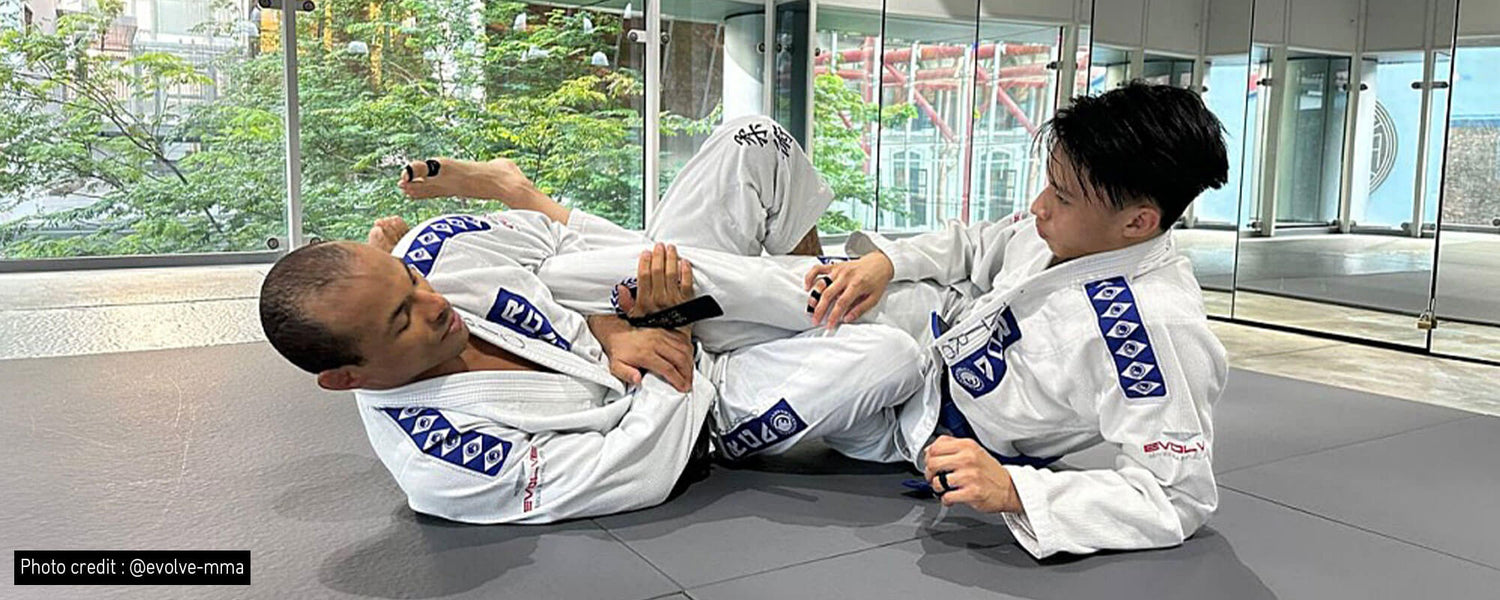Table of content
1. Introduction

Brazilian Jiu-Jitsu, abbreviated to BJJ, is an interesting martial art and combat sport involving grappling and ground fighting. BJJ practitioners can use joint locks and chokes to dominate positions and force opponents to submit. Control and submission are two main points that make BJJ an excellent self-defense and an exciting and strategic competition sport.
One of the most delicate moves in BJJ techniques is the honey hole, an excellent position for leg entanglement on the strong leg. This is also called the 411 position or saddle, offering exceptional control over an opponent's leg. Very effective setup configurations lead to successful leg locks, especially heel hooks.
Within the honey hole, a controlling grappler takes up one of the opponent's legs through a series of leg entanglements that deny him mobility. This exciting and technical position shows the intricate and strategic nature of Brazilian Jiu-Jitsu.
1.1 BJJ is a martial art and combat sport
Brazilian Jiu-Jitsu is a combat sport that teaches martial arts, focusing on grappling and ground fighting. This art uses the critical leverage technique to control or subdue larger opponents independent of strength and size.
BJJ practitioners learn a series of methods, including joint locks and chokes, which are focused primarily on taking positional control with a result that forces the opponent to submit. Given this emphasis on power and submission, BJJ can be applied as a martial art in self-defense and competitive sports
1.2 Defining honey hole position
Brazilian Jiu-Jitsu and submission grappling is called the 411 position or saddle since it's relative to another high-powered leg lock position. The position offers excellent control over an opponent's leg and especially proves handy for leg locks, notably the heel hook.
In the honey hole, the BJJ fighter immobilizes one of the opponent's legs using his legs such that the opponent's knee is pinned and the opponent cannot move around freely.
The controlling opponent's legs are usually entangled, with the trapped leg in a more or less figure-four position. One leg sticks through the opponent's legs and the other wraps around the opponent's far thigh from the outside.
2. Description of such great control over an opponent's leg

This position is favored in No-Gi grappling because it allows for control and ease of joint movement in the leg, but one has to be careful because it can do a lot of harm.
On the other hand, in the martial arts of BJJ, fighters apply the concept of controlling and positioning the opponent. The ground sport involves the leverage method, which may be helpful against more vigorous and oversized opponents.
2.1 Critical Control over an Opponent's Leg
The honey hole position concerns leg locks and positional dominance over the opponent. Leg and hand joints help control the opponent. Honey hole is also a term, but in this case, one can use leg locks in the submission technique.
Different angles apply these leg locks to finish the opponent or the grappler on the ground. To date, this method is the most effective and safest of all the joint lock techniques.
2.1.1.Dominance:
Attaining the honey hole allows you to break your opponent's lower half, and that break is a necessity for the domination of your opponent, especially where grappling comes into play.
Usually, your torso will point toward the trapped leg considerably more or less, giving you more of an advantage in your submissions.
2.1.2.Countering Guard Passes:
Switch to the honey hole if your opponent is trying to pass your guard. The honey hole is an excellent guard-passing technique that can be a tremendous tool when applied perfectly on a submission attempt. The honey hole lets you control the situation and look for opportunities to counterattack.
2.1.3. Submissions:
It is also very favorable for getting into ankle locks, heel hooks, and other leg locks, which are difficult to escape once correctly applied.
The heel hooks have become critical in athletics and safety measures as submission has evolved with time. Knowing how to use the honey hole effectively is extra knowledge in submission.
2.1.4. Defensive Scheme:
The honey hole is an attacking formation that can defend against an opponent trying to beat the guard. The player can use it in both an attacking and a defense role. You may go to sweeps or escapes when they try to turn your position over.
2.2. Backstep Entry into the Honey Hole
2.2.1. Half Guard Set up:
Get an inside leg hooked to yours from this position. You can even be in an underhook on their upper half to create more control. Your head should be in front of your opponent's body and poised to stop being pushed off by your opponent.
2.2.2. Body Control:
Use your arms to frame off the opponent's shoulders or hips. This helps prevent them from pulling or using a counterattack against you.
Bend your knee and transfer your weight to the inside leg closest to the opponent.
Rotate the hips away from the opponent and lock the inside leg. This movement ensures the proper angle for the back step.
2.2.3. Step Back:
Draw a straight line behind your foot, then step back and sideways with the outside leg relative to your opponent. Keep the outside knee of your leg on the ground beside your opponent's leg. This should hit in line with the trapped knee between the two legs.
Keep your hips low so you are in good balance for shot-shooting. Your other leg must be as close to the ground as possible but closer to your opponent.
2.2.4. Swing to the Honey Hole Position:
As you step backward, line up your body so that the leg of your opponent you have pinned is between yours. Reach around with your hands and pin down their knee or ankle. Twist your body around to back into the leg for effortless pressure application and entry to the submission stages.
2.2.5. Pinning the Leg:
Sweep across your opponent's leg and pin it with your hip, shutting off his mobility and range to respond. Submissions open here as an ankle lock, heel hook, or sweep if they roll or pull back
2.2.6. Staying Balanced:
During this execution, maintain the center low to prevent him from getting unbalanced. Please don't make your opponent submit to you; you should keep some control over their torsos and stay keen on the frames.
3. Benefits of Honey Hole in BJJ
3.1. Quick Submission:
The honey hole is a sweet spot where various leg locks can be executed.Heel hooks and ankle locks are particularly effective because they are usually executed quickly and catch a rival off balance.
3.2. Control over opponent:
If your opponent guards against the original submission at the honey hole, you can effortlessly switch to other dominant positions, including side control or mount.
3.3. Transition and Dominant Positions:
The motion constantly changes, so you present yourself to the opponent needing clarification and look for sweeps whenever possible.
The honey hole puts a better position when hunting the pride, in a sporting game where you fight, or even in self-defense cases.
Getting into and out of this position becomes an issue of knowing how to do it well; this may become an advantage for competition-oriented events.
3.4. Unpredictability and Defensive:
The tendency to hover around idle is unpredictable, so your opponents cannot make proper strategies against you. But, apart from being the offense-playing strategy, the honey hole can also be a defensive strategy.
It allows changing one's position from bad to better to evade unfortunate incidents. So when you are in a compromising guard position, you can regain control and enter the honey hole to have offense
4. Conclusion

The honey hole position in Brazilian Jiu-Jitsu is a technical and efficient move that can give its user the best control over the opponent’s leg. One needs to have skills in how technical moves and how strategic this position is. The honey hole, also called the 411 position or saddle, is a good starting position for applying leg locks, especially the heel hook, and controlling the opponent’s leg while preventing him from moving.
With this intricate and technical position, people will be able to understand further the extent and essence of Brazilian Jiu-Jitsu, whether for practical use or competition. The honey hole also displays flexibility in defense and offense as the practitioner uses it to counter guard passes, use different leg locks, and switch between attack and defense.
The backstep entry to the honey hole from the half-guard position also shows the depth of control and the concept of the technique involved in the fight.
With time, Brazilian Jiu-Jitsu becomes more advanced, and integrating the honeyhole position will make your grappling more strategic. When used in defense cases or even martial arts performances, the honeyhole position is the best example of Brazilian Jiu-Jitsu tricks, essential for every BJJ learner or competitor.
5. Frequently Asked Questions (FAQs)
Q: What about the honey hole position in BJJ?
The honey hole position, also called 411 or saddle, is one of the most formidable leg entanglement positions in Brazilian jiu-jitsu. It gives much control over the opponent's leg and is very good for applying leg locks, especially a heel hook.
Q: Why is the honey hole position so important in BJJ?
With the honey hole position, you have dominant control over the opponent's leg and leg lock opportunities, which are very important in BJJ.
Q: What are the reasons for favoring the honey hole position in BJJ tactics?
The honey hole position is favorable for controlling the lower half of the opponent, controlling the position for submission, defending guard passes, and countering leg locks.
Photo credit: @evolve-mma












Leave a comment
This site is protected by hCaptcha and the hCaptcha Privacy Policy and Terms of Service apply.